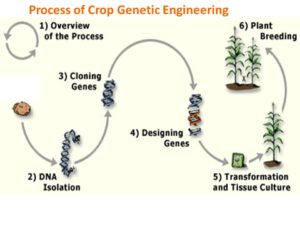Genetically Modified Mustard.
Relevance
- GS Paper- 3
- Indigenization of technology and developing new technology.
- Awareness in the fields of IT, Space, Computers, robotics, nano-technology, bio-technology
- Tags: #upsc #gene-editing #GMcrops #GM-mustard #GEAC.
Why in the News?
- Recently, a Supreme Court bench sought a ban on the commercial cultivation of indigenously developed genetically modified mustard crops (HD Mustard DM-11) citing the reason of safety threats to public health, environmental safety, and socio-economic considerations.
- Indian scientists have developed the first-ever low-pungent mustard that is pest and disease-resistant and is based on CRISPR/Cas9 gene editing technology. This is the first time a transgenic food crop is planned to be commercially cultivated in India.
What is Genetically Modified Mustard?
- It is a Herbicide Tolerant (HT) mustard variety that has undergone genetic modification. It has two alien genes —“barnase” and “barstar” — isolated from a soil bacterium called Bacillus, amyloliquefaciens. It enables the breeding of high-yielding commercial mustard hybrids.
- The environment ministry allowed the environmental release of the Dhara Mustard Hybrid (DMH-11), a transgenic mustard developed by Delhi University for its seed production.
- At present, Cotton is the only GM crop allowed for cultivation in India.
- GEAC (Genetic Engineering Appraisal Committee), the country’s regulator for genetically modified organisms.
About Barnase and Barstar technologies?
- The barnase-barstar system is an indelible technique to produce hybrid seeds in self-pollinated crops. The scientists have deployed this technology to produce the Genetically Modified (GM) mustard variety DMH (Dhara Mustard Hybrid)-11.
- The barnase gene codes for a protein that impairs pollen production and renders the plant into which it is incorporated male-sterile.
- This plant is then crossed with a fertile parental line containing the barstar gene that blocks the action of the barnase gene.
- The resultant F1 progeny is both high-yielding and also capable of producing seed/ grain.
Contribution of Oilseeds in Indian Economy
- As per the US Department of Agriculture- India’s most significant domestically-grown oilseed is rapeseed mustard. Its share in the country’s production of vegetable oils has been estimated at 42.6% (more than soybeans 19.2%) and in that of meal at 30.3% (next to soybeans 38.9%).
- Oilseeds yield not only oil for cooking and frying. Their so-called meal – the residual cake after extraction of oil from the seeds – is a protein-rich ingredient used in livestock, poultry, and aqua feed.
What are the benefits of GM Mustard?
- GM crops can be used for commercialization.
- It increases crop productivity and Yields are expected to rise by up to 30 percent.
- It is also cost-effective because these organisms are designed to be pest-resistant, which eliminates the need for pesticides and saves money.
- India Plans for food fortification to achieve SDG, this will help to achieve its goal and sustain food security.
- India imports 15 million tonnes (Mt) of edible oils worth almost $11 billion annually, Mustard oil production from this variety of crop will save a lot on the import price.
Concerns related to the cultivation of GM Mustard
- According to activists and farmers, GM mustard is a herbicide-tolerant crop, and toxic chemicals sprayed on the plant would impact the health of the people consuming it.
- It is environmentally unsustainable and does not suit Indian agricultural conditions.
- The approval demonstrates the total failure of India’s limited biosafety regulations and also showcases the serious deficiencies in the regulatory regime.
- Lack of regulatory guidelines and protocols for HT crops has raised apprehensions over the testing of GM Mustard as herbicide-tolerant crops.
About GM Crops.
What are Genetically Modified crops?
GM is a technology that involves inserting DNA into the genome of an organism. To produce a GM plant, new DNA is transferred into plant cells. Usually, the cells are then grown in tissue culture where they develop into plants. The seeds produced by these plants will inherit the new DNA thus resulting in new modified crops.
What is the difference between genetically engineered and genetically modified crops?
Furthermore, the main difference between genetic engineering and genetic modification is that, in genetic engineering, foreign DNA is introduced to a cell from an unrelated species while, in genetic modification, the current genetic material is modified to produce a new characteristic.
What are the benefits of GM crops?
- Several GMO crops have been engineered to make them less vulnerable to pests and bugs. Bt-corn, for example, is a GMO crop containing a gene from Bacillus thuringiensis, a soil microbe.
- Greater tolerance of stress, such as drought, low temperatures or salt in the soil.
- High yield and faster growth, they can be cultivated and harvested in areas with shorter growing seasons.
- More nutritious, and tastier.
- May be possible to produce medicines or even vaccines.
- Can be made resistant to specific herbicides.
Points To Remember
- Transgenic Crops
- Gene Editing
- Crisper CAS9
Source: The Indian Express, Economic Times, Livelaw.
Mains Question
What are genetically engineered crops. How they are different from genetically modified crops. What are the impacts of GM crops on economy and society.




